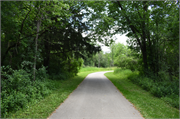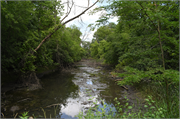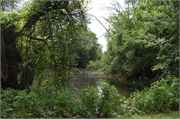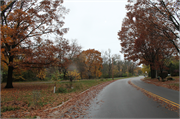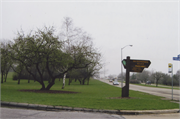| Additional Information: | A 'site file' titled "Menomonee River Parkway" exists for this property. It contains additional information such as correspondence, newspaper clippings, or historical information. It is a public record and may be viewed in person at the Wisconsin Historical Society, State Historic Preservation Office. 2011-
Resurveyed; appearance unchanged.
2006-
Approximately 5.1 miles long, runs between Congress Street and Harmonee Avenue. The Parkway is part of an oval-shaped chain of parkways that loop around Milwaukee County; the Menomonee River Parkway includes 19 resources: 9 contributing and 10 noncontributing. Six building are located within the Parkway as well as a swimming pool, 12 vehicular bridges, a culvert, a pedestrian bridge, and the road itself. Important landscape features include the Menomonee River, park space, lagoons, springs, and retaining walls. Major intersecting roads are STH 100/Mayfair Road, Burleigh Street, North Avenue, and Swan Boulevard. Currie and Hoyt Parks are located along the Parkway. The east side of the Parkway is lined by residential homes while the west side is adjacent to the Menomonee River.
Resurveyed April 2010; appearance unchanged.
The first plans for a series of Milwaukee County parkways was developed in 1923, illustrating a number of curvilinear drives along the waterways of Wauwatosa. Portions of the eventual Upper Menomonee River Parkway were purchased in 1926, with additional property added through the 1930s. In 1935, the county began constructing the parkway and drive with Civilian Conservation Corp laborers conducting most of the work including moving the river channel, excavating lagoons, street grading, masonry work, construction of concrete bridges, and the construction of a small comfort station building. In the 1950s more bridges were added to the Upper Menomonee River Parkway.
The Upper Menomonee River Parkway covers 555 acres from Harmonee Avenue to Congress Street. The Upper Menominee River Parkway, which includes Currie Park and Golf Course and Hoyt Park, has a drive that follows the river closely in a curvilinear path meant as a pleasure drive. The parkway includes many small-scale elements including retaining walls, bridge piers, bollards, bridges, lighting, and signage. The largest of these are the WPA built retaining walls constructed along the parkway.
2024 - Landscaped Park along five miles of the Menomonee River featuring several outbuildings, retaining walls, bridges, golf courses, city parks, signage, and the roadway.
The Upper Menomonee River Parkway stretches along the length of the Menomonee River between Harwood Avenue and Hampton Avenue in the City of Wauwatosa covering approximately 555 acres and stretching over five miles long; some of which was included in the APE of this report. The Parkway in total includes a drive that intentionally follows the river closely along a curvilinear path for scenic purposes, it also includes Currie Park and Golf Course, Hoyt Park, and many smaller features including stone retaining walls, small service buildings, bridge piers, bollards, stone and concrete bridges, lagoons, springs, lighting, stone retaining walls, and signage. The parkway is part of a larger chain of parks that loop around Milwaukee County in an oval shape, linking many of the park features together and often following waterways. Adjacent to the parkway are residential neighborhoods and houses that typically have a direct view of the parkway.
The initial plans for a series of Milwaukee County parkways and infrastructure were developed by Charles Whitnall in 1923, including a series of curvilinear drives adjacent to the rivers in Wauwatosa . Land was purchased beginning in 1926 along the Menomonee River and subsequent acquisitions by the County were made during the following decade. Work did not begin until 1935 when the Civilian Conservation Corp. (CCC), using federal funding in support of Milwaukee County efforts, began most of the construction including moving and dredging the river channel, excavating lagoons, building roadways and bridges, street grading, masonry work on retaining walls, and park structures and buildings. Several more bridge crossings were added in the early 1950s and subsequent maintenance and upgrading have further contributed to the Menomonee River Parkway.
The Upper Menomonee River Parkway is an example of an important, intact twentieth century planned parkway in Milwaukee County having local significance in the area of community planning and development. The Parkway, and its various contributing resources, retain their historic integrity in terms of location, workmanship, design, feeling, setting, and association. Some alterations to features, such as roadways and bridges, have taken place that diminish the material integrity of the parkway and as a resource. Furthermore, the Upper Menomonee River Parkway is one of several such parkways following dozens of miles through Milwaukee County and its design is far from unique. The parkway is not considered significant for its design. No single individual is explicitly related to the parkway’s development. The Upper Menomonee River Parkway possesses integrity and significance with respect to its contribution to history of planning and development, with a period of significance spanning the years of construction and additions to the Parkway from 1926 to circa 1970, when the Parkway looked much as it does presently.
|
|---|
| Bibliographic References: | Mead and Hunt. Volume 1: Milwaukee County Parkway Inventory Report. Milwaukee County Department of Parks, Recreation, and Culture, 2012.
2024 - Historic Architectural Survey, Granville CPCN; Cities of Milwaukee, Wauwatosa, Brookfield, Waukesha, and New Berlin; Villages of Butler, Lannon, Germantown, and Menomonee Falls; Milwaukee, Washington, and Waukesha Counties, Wisconsin – Stantec |
|---|

